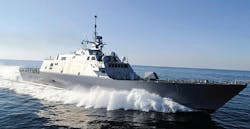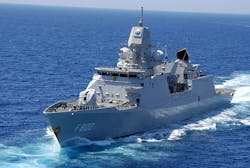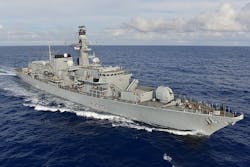Navy looks to modified littoral combat ship design to serve as next-generation frigate
THE MIL & AERO COMMENTARY, 15 March 2016. Naval surface warships like the frigate have filled a variety of diverse-yet-specific roles throughout history, such as projecting power, surface escort, command and control, and logistics support. Each has its place and serves as an integral cog in the machine of naval power.
The so-called capital ships, or the most powerful vessels in the fleet, are the instruments of projecting power. Today those are the aircraft carrier, amphibious assault ship, and to a more limited degree the guided missile cruiser. In the 18th century the heavily armed ship of the line projected power, and in the late 19th and early 20th centuries the battleship filled this role.
Surface escort ships like destroyers and frigates traditionally protect the powerful capital ships, and provide escort protection to lightly armed naval surface warships, as well as to commercial or military merchant ships.
Escort ships, throughout history and up to this day, play a crucial role of keeping naval battle groups together, intact, and functioning in the face of the enemy. They screen ships from aircraft and submarine attack, and can act as advance scouts to determine what's beyond the battle group's horizon.
Related: New ship takes lead in countermine and anti-submarine warfare
Today's ships, however, are evolving away from their core escort missions. The U.S. Navy's Arleigh Burke-class destroyer, for example, has become a powerful vessel in its own right and increasingly operates independently in roles like seaborne ballistic missile defense.
At the other end of the scale, the Navy's littoral combat ship (LCS) is taking on new roles of counter-mine warfare, ocean search-and-seizure, and reconnaissance of coastlines and harbors.
At the same time the Navy's traditional frigate has fallen by the wayside. The Perry-class frigate -- the U.S. Navy's last group of surface warships so-named -- saw its last ship retired last fall.
Today there are no frigates in the U.S. Navy, which has created a gap in the Navy's anti-air and anti-submarine escort capabilities.
Related: A once-proud class of U.S. Navy surface warships is quickly fading away
This hasn't gone unnoticed in the naval high command, however. Recognizing the need for frigates, leaders of the Navy and U.S. Department of Defense (DOD) have agreed to modify late-model littoral combat ships with more armor and more powerful anti-aircraft and anti-submarine capabilities and rename them frigates. As of this writing, Navy leaders plan to build a total of 40 LCS vessels, and at least 12 of them will be built as frigates.
Navy leaders plan to base the future frigates on just one type of the littoral combat ship; they haven't decided yet which one. The Freedom class, at 3,900 tons, is the larger of the two.
Even if the Freedom-class littoral combat ship ends up as the Navy's next frigate, the ship will be on the small side, compared with other operating frigates. The De Zeven Provinciën-class frigate of the Royal Netherlands Navy, for example, displaces 6,000 tons. The United Kingdom Royal Navy's Duke-class Type 23 frigate displaces 5,400 tons. Even the old Perry-class frigates at 4,200 tons were larger than the Navy's new frigates most likely will be.
Related: Navy chooses AAI Textron to provide mine-hunting unmanned boat for Littoral Combat Ship
Transforming the littoral combat ship design to a frigate also has its drawbacks. The original LCS was designed for speed, and the two types reportedly can approach speeds of 47 knots. The frigates, however, will be heavier for enhanced survivability and more powerful weapons. The price of that extra protection and armament will be a reduction in speed, experts say. How much of a reduction remains unclear.
Still, the redesigned frigate is likely to be fast compared to the larger frigates in other navies. Even if the LCS-based frigates can still steam at speeds faster than 35 knots, they'll be faster than the Duke-class and De Zeven Provinciën-class frigates, which top out at around 28 knots.
We can't know yet how well the Navy's plan of modifying the littoral combat ship into a frigate will work out. Navy surface warfare officers eventually may regret their decision not to design a new frigate from the ground up.
Still, that gap in naval surface escort capability will be narrowing soon. The first LCS-based frigates should go to sea sometime in the next decade.




